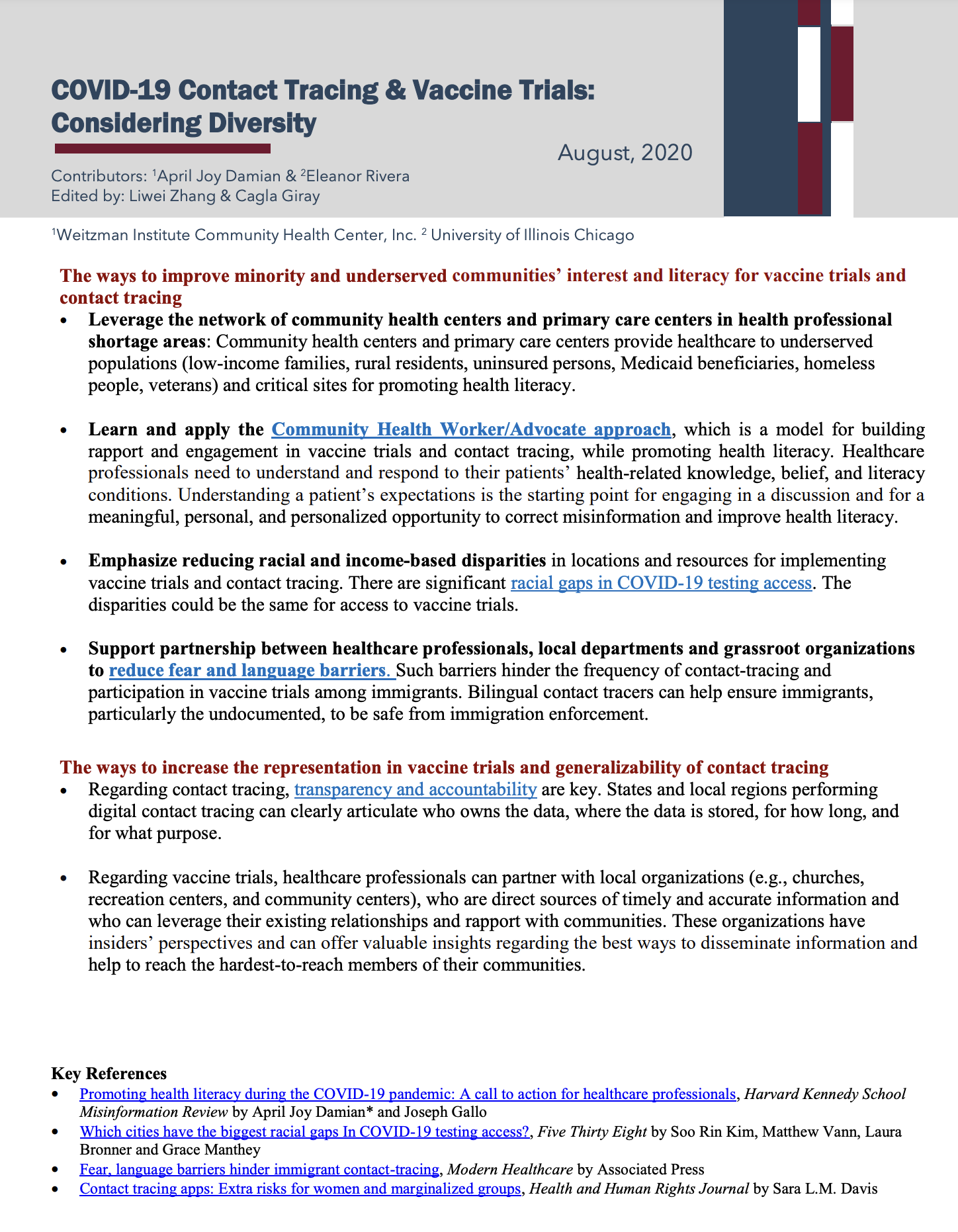
The ways to improve minority and underserved communities’ interest and literacy for vaccine trials and contact tracing
- Leverage the network of community health centers and primary care centers in health professional shortage areas: Community health centers and primary care centers provide healthcare to underserved populations (low-income families, rural residents, uninsured persons, Medicaid beneficiaries, homeless people, veterans) and critical sites for promoting health literacy.
- Learn and apply the Community Health Worker/Advocate approach, which is a model for building rapport and engagement in vaccine trials and contact tracing, while promoting health literacy. Healthcare professionals need to understand and respond to their patients’ health-related knowledge, belief, and literacy conditions. Understanding a patient’s expectations is the starting point for engaging in a discussion and for a meaningful, personal, and personalized opportunity to correct misinformation and improve health literacy.
- Emphasize reducing racial and income-based disparities in locations and resources for implementing vaccine trials and contact tracing. There are significant racial gaps in COVID-19 testing access. The disparities could be the same for access to vaccine trials.
- Support partnership between healthcare professionals, local departments and grassroot organizations to reduce fear and language barriers. Such barriers hinder the frequency of contact-tracing and participation in vaccine trials among immigrants. Bilingual contact tracers can help ensure immigrants, particularly the undocumented, to be safe from immigration enforcement.
The Ways to Increase the Representation in Vaccine Trials and Generalizability of Contact Tracing
- Regarding contact tracing, transparency and accountability are key. States and local regions performing digital contact tracing can clearly articulate who owns the data, where the data is stored, for how long, and for what purpose.
- Regarding vaccine trials, healthcare professionals can partner with local organizations (e.g., churches, recreation centers, and community centers), who are direct sources of timely and accurate information and who can leverage their existing relationships and rapport with communities. These organizations have insiders’ perspectives and can offer valuable insights regarding the best ways to disseminate information and help to reach the hardest-to-reach members of their communities.
Key References
- Promoting health literacy during the COVID-19 pandemic: A call to action for healthcare professionals, Harvard Kennedy School Misinformation Review by April Joy Damian* and Joseph Gallo
- Which cities have the biggest racial gaps In COVID-19 testing access?, Five Thirty Eight by Soo Rin Kim, Matthew Vann, Laura Bronner and Grace Manthey
- Fear, language barriers hinder immigrant contact-tracing, Modern Healthcare by Associated Press
- Contact tracing apps: Extra risks for women and marginalized groups, Health and Human Rights Journal by Sara L.M. Davis
The Research-to-Policy Collaboration (RPC) works to bring together research professionals and public officials to support evidence-based policy. Please visit their website to learn more.
Key Information
RPC Website
Research-to-Policy Collaboration
More RPC Resources
RPC Resources
Publication DateAugust 1, 2020
Topic Area(s)Community-Specific, Equity, Health
Resource TypeWritten Briefs
Share This Page
The ways to improve minority and underserved communities’ interest and literacy for vaccine trials and contact tracing
- Leverage the network of community health centers and primary care centers in health professional shortage areas: Community health centers and primary care centers provide healthcare to underserved populations (low-income families, rural residents, uninsured persons, Medicaid beneficiaries, homeless people, veterans) and critical sites for promoting health literacy.
- Learn and apply the Community Health Worker/Advocate approach, which is a model for building rapport and engagement in vaccine trials and contact tracing, while promoting health literacy. Healthcare professionals need to understand and respond to their patients’ health-related knowledge, belief, and literacy conditions. Understanding a patient’s expectations is the starting point for engaging in a discussion and for a meaningful, personal, and personalized opportunity to correct misinformation and improve health literacy.
- Emphasize reducing racial and income-based disparities in locations and resources for implementing vaccine trials and contact tracing. There are significant racial gaps in COVID-19 testing access. The disparities could be the same for access to vaccine trials.
- Support partnership between healthcare professionals, local departments and grassroot organizations to reduce fear and language barriers. Such barriers hinder the frequency of contact-tracing and participation in vaccine trials among immigrants. Bilingual contact tracers can help ensure immigrants, particularly the undocumented, to be safe from immigration enforcement.
The Ways to Increase the Representation in Vaccine Trials and Generalizability of Contact Tracing
- Regarding contact tracing, transparency and accountability are key. States and local regions performing digital contact tracing can clearly articulate who owns the data, where the data is stored, for how long, and for what purpose.
- Regarding vaccine trials, healthcare professionals can partner with local organizations (e.g., churches, recreation centers, and community centers), who are direct sources of timely and accurate information and who can leverage their existing relationships and rapport with communities. These organizations have insiders’ perspectives and can offer valuable insights regarding the best ways to disseminate information and help to reach the hardest-to-reach members of their communities.
Key References
- Promoting health literacy during the COVID-19 pandemic: A call to action for healthcare professionals, Harvard Kennedy School Misinformation Review by April Joy Damian* and Joseph Gallo
- Which cities have the biggest racial gaps In COVID-19 testing access?, Five Thirty Eight by Soo Rin Kim, Matthew Vann, Laura Bronner and Grace Manthey
- Fear, language barriers hinder immigrant contact-tracing, Modern Healthcare by Associated Press
- Contact tracing apps: Extra risks for women and marginalized groups, Health and Human Rights Journal by Sara L.M. Davis
The Research-to-Policy Collaboration (RPC) works to bring together research professionals and public officials to support evidence-based policy. Please visit their website to learn more.

Key Information
RPC Website
Research-to-Policy Collaboration
More RPC Resources
RPC Resources
Publication DateAugust 1, 2020
Topic Area(s)Community-Specific, Equity, Health
Resource TypeWritten Briefs
Share This Page
LET’S STAY IN TOUCH
Join the Evidence-to-Impact Mailing List
Keep up to date with the latest resources, events, and news from the EIC.




